
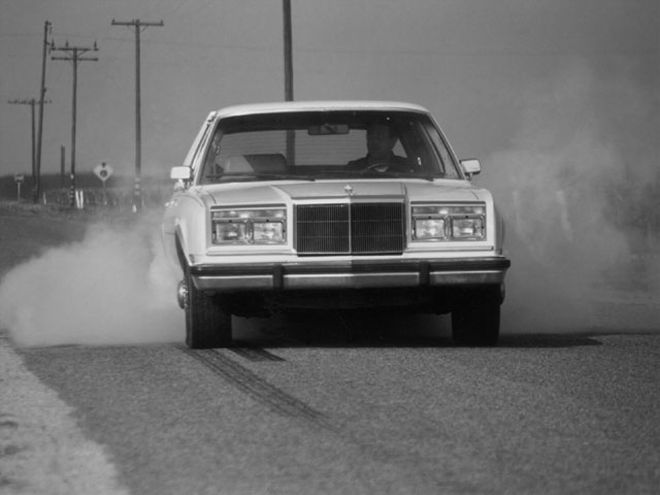
What Happens When You Take One $600 Junkyard M-Body Fifth Avenue, Add 400 Ft-Lbs Worth Of 360 Small-Block, A 727, Cop Suspension, And Open Road 2.71:1 Gears? If Not The Ultimate Q-Ship, It Has To Be The Definitive Vegas Cruiser.
The progressive demise of the traditional rear-wheel-drive Mopar passenger car was simply one of attrition. To wit, the A-Body was gone after '76, C-Bodies made their final appearance in '78, and the B-Body was killed the following year (the B- lived on for three more years in stretched form as the R-Body cars, but that was axed for '82). The first replacement for the traditional Mopar was the F-Body, which debuted in 1976. The most notable change with the F-cars was the switch to a transverse front torsion-bar suspension, replacing the longitudinal torsion bars. The M-Body appeared in 1977, followed by the two door J-Body in 1980. The F-, M-, and J-Bodies were all nearly identical under the skin, taking the same suspension and drivetrain components across the board. F-Body production ended in 1980. The truly massive carnage came with close of 1983; the J-Body, the short-lived Imperial, and the two-door M-Bodies were finished all. From that point, all that remained of traditional RWD Mopar heritage was the ubiquitous four-door M-Body.
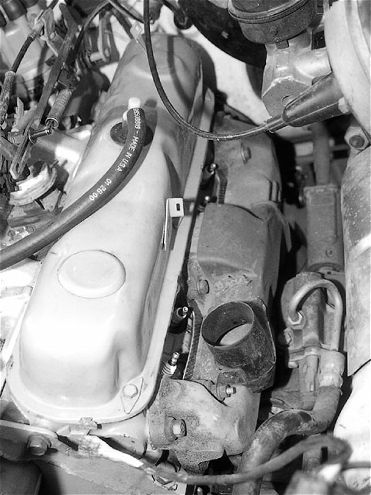 Though in the dyno test the engine ran a set of Hooker 151/48-inch headers, factory 360 manifolds got the nod to keep noise down and emissions inspectors at bay.
Though in the dyno test the engine ran a set of Hooker 151/48-inch headers, factory 360 manifolds got the nod to keep noise down and emissions inspectors at bay.
In the crush of FWD econoboxes pumped out by Chrysler from 1984-'89, the rear- wheel-drive M-Body Gran Furys, Diplomats, and Fifth Avenues stood alone. M-Body production in the final years was sort of a Jekyll and Hyde story, with production split between the tough, stripped-down (though underpowered) Diplomat and Gran Fury Police cruisers, and the sissy-soft, but plush and decked-out New Yorkers and Fifth Avenues. When Chrysler pulled the plug on the M-Body at the end of the '89 model run, the traditional Mopar was dead. With no reputation outside of law enforcement, few were teary eyed to see the M-Body go.
For you, Dear
"I need a new car," was the wife's request ringing in my ears. She had a point. With another baby on the way and the current child safety seat laws, loading the family into our two-door '69 Dart was turning into an ordeal. A new car? When you can build practically anything, it seemed senseless to pick up a payment book. It was time to work out a plan, strike a compromise, if you will.
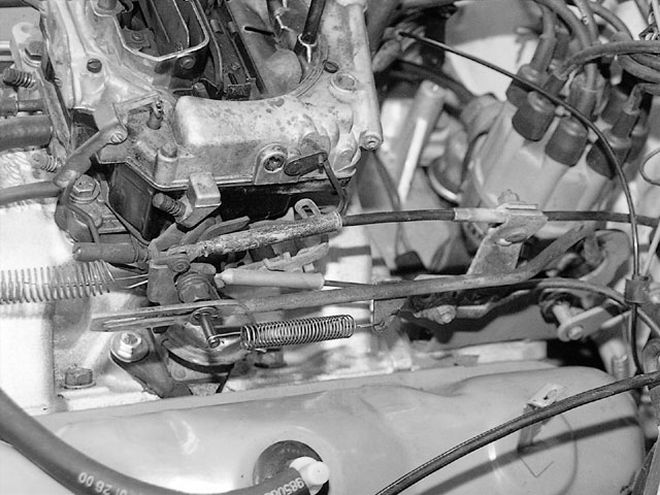 A stock TQ carb went back on the 360. When working right, little can touch it for output, and it looks stock. The four-barrel required the corresponding kickdown and throttle linkage, a common junkyard setup on late model 318 4Vs.
A stock TQ carb went back on the 360. When working right, little can touch it for output, and it looks stock. The four-barrel required the corresponding kickdown and throttle linkage, a common junkyard setup on late model 318 4Vs.
"How about a nice old Jeep? A nice, roomy, four-door Jeep Grand Wagoneer?" It seemed like a worthy give-and-take, even a defacto Mopar; I'd just have to find that sweet cream puff. Six weeks of looking at overpriced worn-out junk and reality was beginning to set in-it'd take some strange luck to find that mint wagon. Then it appeared.
No, it wasn't the Jeep by a long shot. Walking the Mopar section of the local boneyard, a battered forklift ambled in with the latest carcass, dropping it in line on the empty pipe stands. A New Yorker Fifth Avenue. A very clean one. White, with gray leather, power everything, and other than dings in the rocker trim left by the forklift, there wasn't a scratch on it. The wheels started turning: four doors, OK. Hot small-block, SureGrip, 727, cop suspension, it'll all bolt in. It was meant to be, but would it fly? There was only one way to find out-just roll the dice. Six bills changed hands and it was mine. "Honey, I got your new car."
The '83 M-Body, with a scant 86,000 miles on the clock, was definitely garaged and pampered all its life. What sent it to the scrapyard? A locked-up 318.
"I like it, where's the keys?" PAYDIRT! Sure, there was some explaining to do, like, "Well, hon, it needs a new engine. And don't ask where I found it," but the first hurdle was cleared. A blown engine with practically any other used car would have been a serious shortcoming, but on the Fifth, I looked at it as an asset. After all, any small-block would be a simple swap out, and more muscle under the hood is just what these late-model Mopars desperately need. It was a blank page with only two constraints: it had to squeak by an emissions test, and meet my wife's single request, "Don't make it loud."
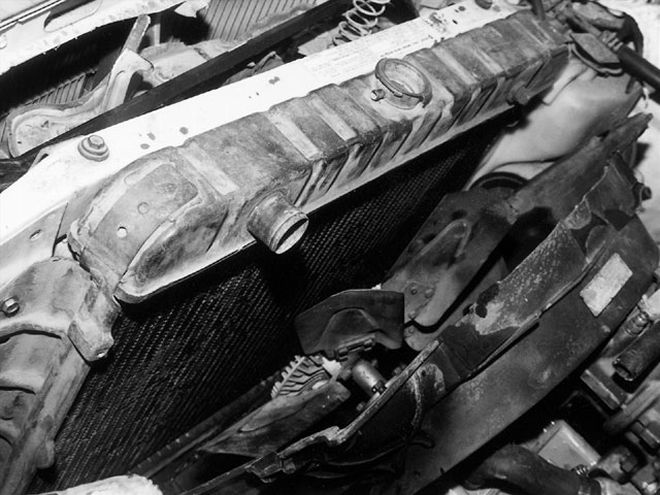 To provide trouble-free cooling capacity, the ridiculously thin factory single-row radiator was tossed. A 26-inch three-row core radiator fitted with M-Body brackets went in wearing a factory shroud, with the air moved by a huge junkyard seven blade viscous fan.
To provide trouble-free cooling capacity, the ridiculously thin factory single-row radiator was tossed. A 26-inch three-row core radiator fitted with M-Body brackets went in wearing a factory shroud, with the air moved by a huge junkyard seven blade viscous fan.
Drivetrain Drop
A new engine was a given, but what would it be, another 318? The answer came when the second stroke of luck came my way, a remanufactured 360 engine found at the wrecker's in an '83 one-ton chassis cab truck ('79 block). The low compression 360 would allow the engine to run on cheap 87 octane regular gas while the added 40-plus cubes of Mopar's biggest small-block would provide the torque to propel this heavy luxo-barge down the road like a musclecar. Tweaked on the dyno with a Comp XE 262 cam kit and an Edelbrock EGR manifold, the low-compression 360 turned in 335 hp and a fat 400 ft-lbs of torque in a package that should pass the smog test (see "Smog Dog Dyno Flog" - May 2001). Engine: done.
Next, what about the rest of the drivetrain? The stock 904 was an unknown quantity, and the small Torqueflite was never used in a factory application behind a 360. Also, all 360s are externally balanced, and thus no production small Torqueflite torque converters were produced with the eccentric balance weight for the 360. This in itself isn't an obstacle, since the appropriate weight can be welded onto a 904-style torque converter (we've done it in the past), but for street reliability, the larger 727 Torqueflite seemed like a better choice. I already had a built, late-model A-engine 727 in the shop, complete with a special high-stall 11-inch lock-up torque converter-perfect. For this swap, the speedo cable and cooler lines also worked, but the late-model neutral safety switch from the small trans was needed to mate with the late-type wiring connector (the switches interchange). Transmission: done.
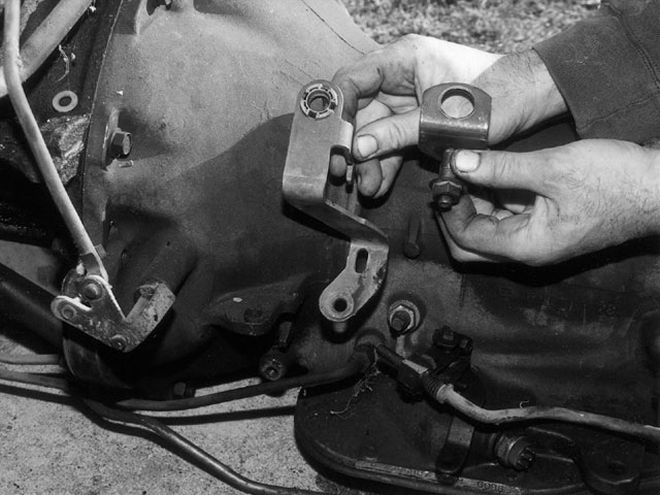 Mating the stock 904-style column shift linkage to the 727 required using the 727-style short bracket (right), instead of the offset 904 bracket (left).
Mating the stock 904-style column shift linkage to the 727 required using the 727-style short bracket (right), instead of the offset 904 bracket (left).
With the engine and trans on hand, it was time to turn some wrenches on the Fifth. The 360 is a bolt-in replacement for a 318, though there is a slight variation in the lefthand (driver's) motor-mount lug on the side of the block. The lugs consist of two bolt holes at the front boss and a single hole at the rear boss. The rear boss on the 360 is about 31/48-inch further forward than on the 318. There are narrower engine mounting brackets for the 360, but to use the 318 bracket, all that's needed is a spacer between the rear lug and the bracket. With a 11/42-inch nut for a spacer, the 318's bracket bolted right up. Since the Fifth was originally a two-barrel, a four-barrel throttle-linkage bracket and trans kickdown arm were required, a common item on 318 or 360 four-barrels and found at the boneyard.
The engine and trans were bolted together and dropped into the Fifth as a unit. The trans aligned with the stock crossmember, and used the same mount as the smaller 904. The factory shift linkage also lined up and worked with the 727, though the pivot bracket for the shift bellcrank at the trans needed to be the shorter 727 piece. The kickdown linkage was the original three-piece setup from the smaller trans, which worked, though from the engine pivot-bracket forward, the four-barrel bracketry is required. Even the original trans cooler lines worked perfectly, with a minor amount of tweaking.
Finishing off the engine swap, all of the front accessories and brackets from the 318 were bolted onto the 360, including the original axial air-conditioning compressor. To make sure cooling wouldn't become a problem, an old style Mopar three-row-core H/D 26-inch radiator was grafted to a set of M-Body mounting brackets and mated to a factory shroud. The air is pulled by a huge seven-blade viscous-drive fan, and a Milodon 160-degree balanced-flow thermostat completed this cooling system. As a result, the temperature gauge needle barely moves. To handle the ignition, the factory ESA computer system was shelved in favor of a Mopar Performance electronic ignition conversion kit. The electronic outift certainly isn't a true emissions-legal replacement, but once installed, it looks stock enough to probably get by a smog check.
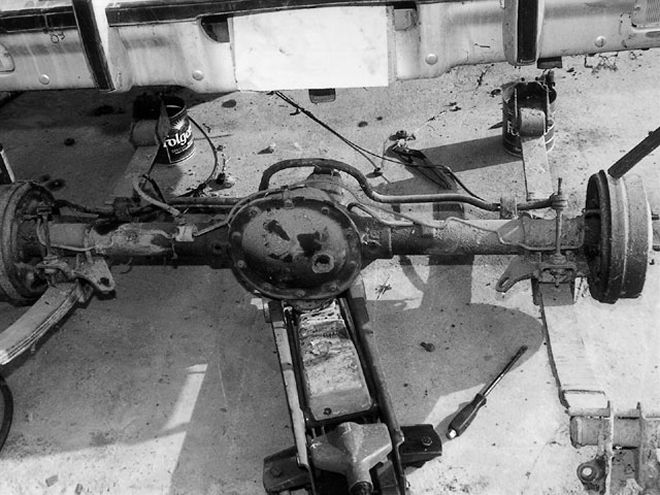 The Fifth came with a 2.2:1 geared 7 1/4-inch rear, too weak and with the wrong gears for the modified car. An ex-police Diplomat had the 2.71:1 8 1/4-inch rear I wanted, plus the stout police package rear suspension. The entire rear and suspension was dropped out as a unit by just backing out 12 bolts. The toughest part was unhooking the parking brake cables.
The Fifth came with a 2.2:1 geared 7 1/4-inch rear, too weak and with the wrong gears for the modified car. An ex-police Diplomat had the 2.71:1 8 1/4-inch rear I wanted, plus the stout police package rear suspension. The entire rear and suspension was dropped out as a unit by just backing out 12 bolts. The toughest part was unhooking the parking brake cables.
Cold Air Induction
Collecting dust in my garage was an old asymmetrical dual-snorkel air cleaner off a mid '70s 440 C-Body. It was one of those wrecking-yard finds that was snagged for no particular reason other than it was unusual, kind of cool, and cheap. The Fifth originally had a small two-barrel-sized air cleaner with a single cold-air induction snorkel feeding from a duct behind the battery. The dual-snorkel piece had a single cold-air primary snorkel in the same general orientation as the stocker, but also had a secondary snorkel feeding from under the hood that tipped into action at wide open throttle.
Perching the odd dual snorkel on top of the 360's ThermoQuad carb, it fit like a glove, lining up perfectly towards the cold-air duct on the primary snorkel. The secondary snorkel cleared the A/C and heater hoses to the rear, and the oil filler to the front. It was even notched to clear the late model axial A/C compressor, a perfect fit.
There was no doubt the 360 would need more than a single snorkel to breathe, and this unit had the stock looks that would pass a casual visual smog equipment inspection. It seemed odd, though, that the secondary snorkel would draw hot underhood air. To give the 360 cold air from both snorkels, a hole was cut into the right side inner fender apron, and a duct was made from a cut-down air duct culled from another junkyard M-Body. Installed, it looks like it could have been stock.
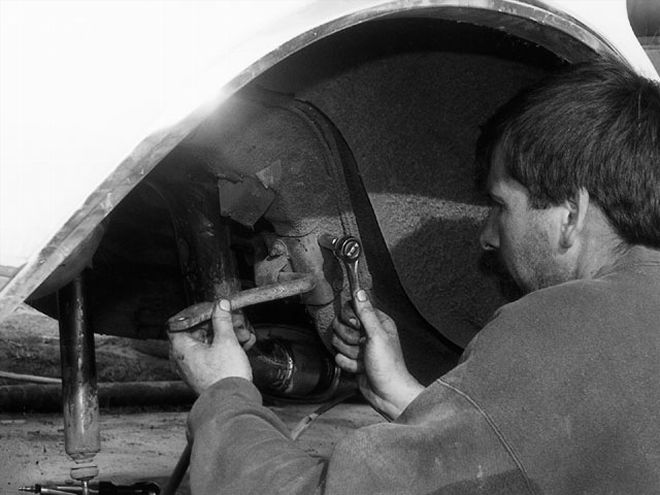 To clear the exhaust, the sway bar had to go in first. All M-Body frames are pre-drilled for the bar.
To clear the exhaust, the sway bar had to go in first. All M-Body frames are pre-drilled for the bar.
Exhaust Upgrade
With the engine in and the induction side done, the exhaust system was next on the list. The stock 318 system is a tortured example of inefficiency, starting with two mini-catalysts bolted right to the restricted manifold exits. From there, the pipes neck out at a strange angle from the primary cats to a single 2-inch main cat, through a muffler, then a resonator, and out the back. Yikes. To the letter of the law, this is the smog legal system, but this machine wasn't going together to the fine points of the code. Making the visual grade in a smog check might just mean that the inspector pokes his head under the car, spies a cat, and moves on. Headers were out on two counts: making the inspection, and my wife's single request that the car wouldn't be loud.
M-Bodies always had a single tail pipe from the factory because of the offset gas tank which leaves exhaust clearance for the tailpipe on only one side. There was a factory "dual exhaust" system available on earlier cars, which used separate pipes off each manifold feeding into two cats, followed by dual mufflers, but after the mufflers the system merged in front of the rear axle out a single resonator and tailpipe. A true dual system can be installed by moving over the gas tank, but that wasn't the plan.
The Fifth would need a cat, but I decided to cut down to just a single cat, a massive high-flow single 3-inch unit. For manifolds, the skinny 318 units were tossed for a set of factory 360 pieces, with the heat riser valve cut out. From there the system feeds into 2 1/4-inch pipes merging to a 3-inch pipe to join the large cat. From the cat back, a single 3-inch pipe carries the exhaust through a short Walker DynoMax turbo muffler and out the back. The system showed minimal back pressure, but is kind of loud. (Sorry, dear.)
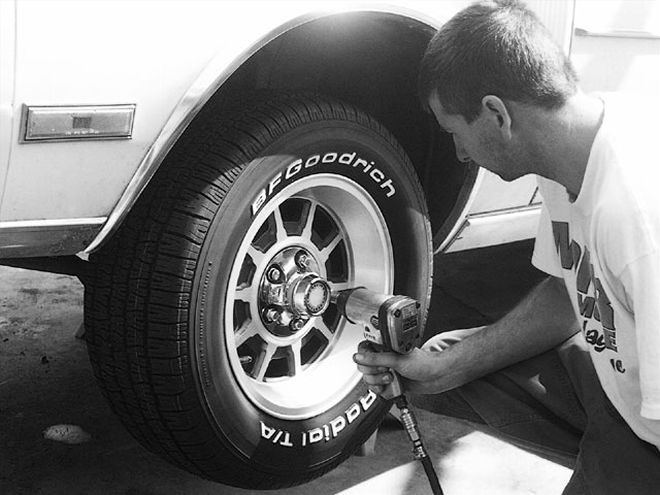 The icing on the cake was scoring a set of 15x7-inch factory road wheels. The wheels were wrapped in a new set of 245/60-15 T/As. Decked out with the fat meats, shocks, and cop suspension, the Fifth handles like it's on rails.
The icing on the cake was scoring a set of 15x7-inch factory road wheels. The wheels were wrapped in a new set of 245/60-15 T/As. Decked out with the fat meats, shocks, and cop suspension, the Fifth handles like it's on rails.
Axle Exchange
Out back, the Fifth was equipped with a puny 7 1/4-inch rearend, like many of these cars, and fitted with incredibly high 2.2:1 gears. Obviously the 7 1/4-inch wasn't up to the task of handling the 400 ft-lbs on tap, so a rearend swap was part of the plan. The largest production rear axle used in the F/J/M-Body chassis was the 8 1/4-inch, not as tough as the legendary 8 3/4-inch, but much more durable than it is given credit for. Since it would be a simple bolt in, and these axles are common as dirt, an 8 1/4-inch rear got the nod. This wasn't going to be a drag car, but with the power from the hot 360 on hand, the Fifth would make a superb high-speed cruiser. I went looking for an 8 1/4-inch rear with a 2.71:1 ratio, and found it in a Diplomat police package car that would be a source for other things as well.
The Cop Connection
One of the nice things about building the M-Body is that the wreckers are flush with cars ready to donate parts to the project at rock bottom prices. Throughout the '80s, the M-Body Mopars were by far the most popular police vehicles in the nation. At least out west, there's a glut of junked police package cars with a wealth of special and heavy duty components ripe for the picking. No, high-performance engines aren't part of the bounty, since all of these cars were equipped with 318s, but the chassis components fit any regular F-, M-, or J-Body car and make them stick like glue.
The Fifth now had the stout 360, a beefy modified high performance 727, and an 8 1/4-inch that was on its way out of a derelict police cruiser. Why stop there? The police car's rear was hanging on a set of special H/D police springs, and located to the chassis by a stout sway bar. The whole enchilada, including the rear axle assembly, brakes, springs, and sway bar was pulled as a unit, upping the ante on the rear of the Fifth to a full police package suspension. The assembly just rolled under the Fifth and bolted-in; the Fifth's frame was even already drilled out for the sway bar brackets. A set of new KYB gas shocks from Performance Suspension Technologies finished off the rear. With the trans and rear-axle change, the driveshaft would need to be about 4 1/2-inches shorter than the original. The stock shaft could have had the trans yoke changed to the larger-splined 727 piece and shortened, but instead a shaft was simply culled from a junked 727, 8 1/4-inch equipped police car.
With the rear now sporting the police hardware, the wallowing front suspension of the Fifth was next. Police package cars came with special H/D torsion bars, and a massive 1.125-inch front sway bar. The transverse torsion bars are much easier to remove than the traditional longitudinal bars of older Mopars. The T-bars and sway bar from the front of the cop car were extracted in an hour and a half at the boneyard with basic hand tools. The service manual details on the procedure, which we will not repeat here (if you are going to do this much work, you'll want a copy anyhow). As in the rear, the cop stuff was just bolted in, and the front suspension got a fresh set of KYB shocks from PST as well.
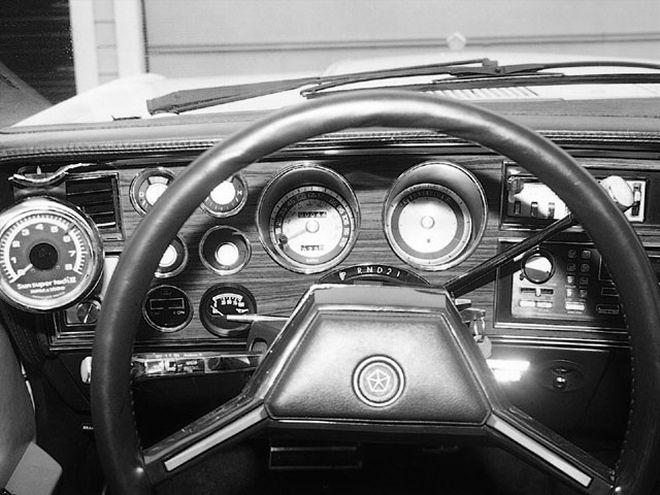 Inside, a cop 125 mph speedo replaced the stock 85 mph piece. A police oil-pressure gauge would go into the lower right gauge hole, requiring that the blanking half of the stock rear-defogger switch be cut back for clearance. The stock radio was chopped out when the car was salvage from the boneyard, requiring repairs to the unbelievably complex wiring to replace it. Finishing off the cluster, the lower right-gauge bezel hole was enlarged to take the police oil-pressure gauge, and a older Sun tach was mounted to the left. A stock electronically-tuned radio cassette was picked up at the wreckers for $7, and the wiring fixed. The O.E. system includes an amp, and sounds good.
Inside, a cop 125 mph speedo replaced the stock 85 mph piece. A police oil-pressure gauge would go into the lower right gauge hole, requiring that the blanking half of the stock rear-defogger switch be cut back for clearance. The stock radio was chopped out when the car was salvage from the boneyard, requiring repairs to the unbelievably complex wiring to replace it. Finishing off the cluster, the lower right-gauge bezel hole was enlarged to take the police oil-pressure gauge, and a older Sun tach was mounted to the left. A stock electronically-tuned radio cassette was picked up at the wreckers for $7, and the wiring fixed. The O.E. system includes an amp, and sounds good.
Rounding out the chassis, my original plan was to salvage a set of 15x7-inch ventilated steel police wheels. Luck seems to runs in threes-besides finding the Fifth and the fresh re-manned 360, the boneyard gods were kind and a gleaming set of 15x7-inch forged aluminum road wheels were dangling from the hubs of an early '80s Dodge Mirada. SCORE! The wheels came complete with chrome center caps and lug nuts, the perfect stylish mags for the Fifth, at the scrap-metal price of $16 each. To plant the Fifth to the pavement, a set of high-performance tires would be a key part of the formula. No junkyard shopping for the sticky meats, here a new set of 245R60-15 BFGoodrich T/A Radials were wrapped around the road wheels at all four corners; a lot of tire to be sure, but an easy fit in the M-Body's large wheel wells. Did the suspension and wide rubber make a difference? There's no gray area here, it was like night and day. The Fifth originally wallowed down the road like a sow in mud. With the good wide rubber, KYB shocks, and the full police suspension, it sticks.
The cop cars also came with 125 mph police speedos, while the speedometers in all of the civilian M-Bodies of the era had the pitiful 85 mph units. So I bagged the speedo as well as the high-quality electronic oil-pressure gauge and sender, another police-only item. Police cruisers were equipped with an extended oil fill pipe for the valve cover-snagged that too. Other cool police stuff included the police tranny, engine, and power steering coolers, electric fuel booster pump (late M-Bodies only), and 100 amp alternators to name a few. Nice pieces all, but for now those will have to wait for another day.
Building the Fifth turned out to be a cheap, quick, and satisfying project. Because all of the parts were bolt-ins and there was no resto detailing, the car came together remarkably quickly. The entire drivetrain swap was done in a weekend, and the car was on the road. The rear suspension was done in an afternoon; ditto the front. Since the body and interior were cherry, the focus became upgrading the wimpy stock mechanicals with H/D or high-performance components. The sweetest part was that practically everything was scammed from the wrecker's at rock bottom prices. The exhaust system and tires meant opening the wallet, but a lot of the parts such as the ignition, radiator, air cleaner, carb, etc. were cast-off or pack-ratted items already taking up space in the garage.
Is it done? These are heavy cars and ours could use more brake. The stock 11-inch front discs are the same size used in the police package M-cars, but a set of late B- or R-Body 12-inch discs can be swapped up front by changing the caliper bracket and adding the big rotors. Out back, the Fifth has 10-inch drum brakes, the same as used in the last few years of M-Body police production, though earlier M-Body police vehicles used 11-inch units. Big brakes all around will eventually be added.
Stock, the Fifth Avenue was luxurious, but woefully underpowered and unstable around corners or at speed. Nearly everything under the skin that makes the car go has been replaced, and the entire character of the car has changed. Though it looks like stock, it hauls, hooks, and handles better than it has any right to, and is downright fun to drive. The hardest part of the build had to be handing the keys over to my better half when it was done.